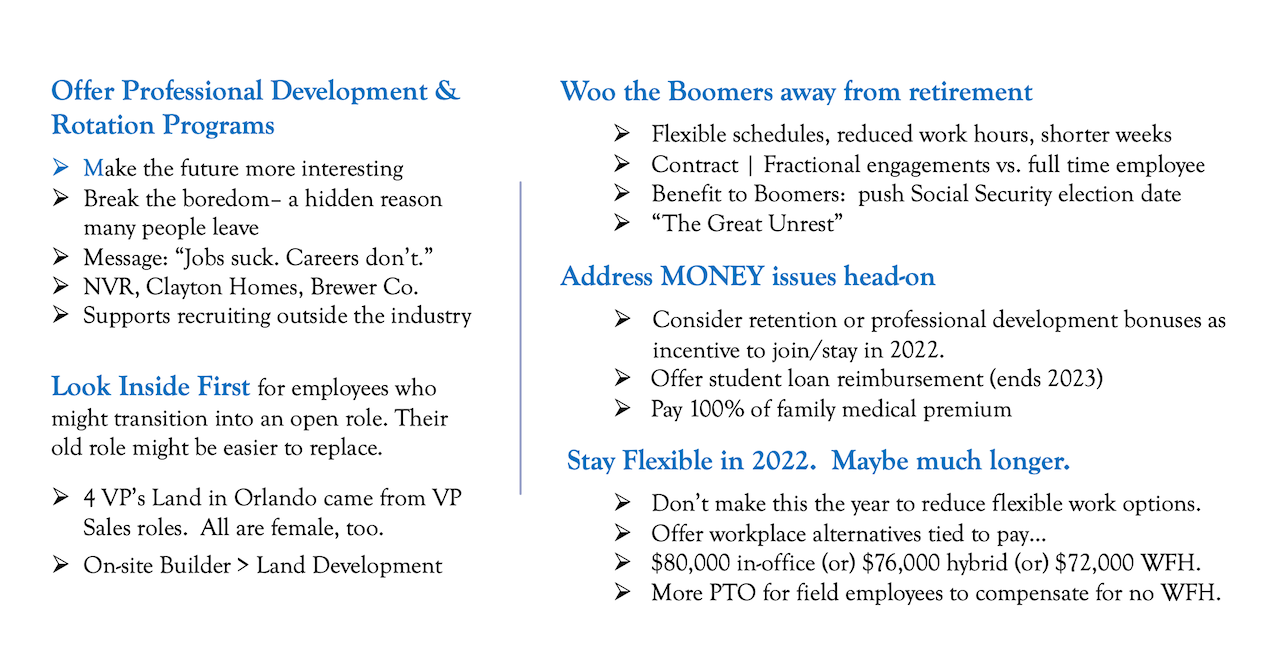Leadership
As External Forces Intensify, Internal Resources Need Focus
Private sector residential real estate and construction leaders now — as always — have to both secure the business' future, and, to do that, secure the present. Their best people are key to both.

Eyes this morning focus on the I for inflation and its trajectory and duration as a corrosive force of economic nature.
Rightfully so. It's where to look first for clues as to what the Federal Reserve will do next to contain it – impacting money supply and borrowing rates. Inflation's connection to each residential construction, design, investment, development, product manufacturing and materials distribution, and real estate ecosystem private sector player's capability for resilience and dynamism in the face of the headwinds punishing businesses and the economy cascades to a single common cultural denominator.
As clues reveal themselves in this calculus of developing dramas around resources, their costs, their market-shifting impacts on households, their motion and intensity and duration and slope of change leaders get two jobs. One is to secure the future for the firm irrespective of how all of these factors and variables evolve.
The other is to secure the present and it's no surprise that if that doesn't happen there's no future to secure. And fact is, there's no way around securing the present without its non-negotiable, essential enabler of anything good that can come of all of this challenge.
People.
You hear it over and over, as often as you'll hear location, location, location as the driver of real estate value, you'll hear "this is a people business," as every private sector real estate and construction company leader's governing principle.
People, their crucial role in capability, and their irreplaceable potential to empower survival, ingenuity, i.e. business fitness for all circumstances. Enterprise leaders and business strategists face challenges of uncertainty on the one hand and clear certainty on the other that they depend on even greater impacts from their talent pools than before.
Leaders' realistic view of who and what they'll have to work with to steer through the bumpy times comes down to requiring more from less. More results. More operational excellence. More positive outcomes. All with less resources to work with on a one-for-one basis.
In that light, words like talent retention mean something different in today's business climate than they did a year, or even six months ago. Talent retention is far more specific and meaningful and consequential to the health and capability of an organization, and that's partly to do with the de-coupling we've been seeing go on as people – mostly in their early to mid-career stages – have been prone to move on and explore new opportunities.
You even see talent – and the evolving i.e. spiralling cost to keep it in the house – showing up in the talk-track in this morning's consumer price index inflation release:
Now what we’re starting to see is that pressure is no longer emanating from the supply side—it’s emanating from the labor-market side. And that’s less likely to go away on its own,” said Aneta Markowska, chief financial economist at Jefferies LLC. “So the Fed will have to work that much harder to get us back to 2% inflation.”
A friend and business associate through the years, Rodney Hall, a partner at Hall | Williams Executive Search, offered perspectives that scope the level of challenge for leaders at a moment , and a series of access points to the organizational choices – the switches and levers so to speak – for firms who want to keep their best people, who, when it comes down to it equate to their best shot at capability through a period of shock and stress.
Rodney's "scope of the challenge" revelation shows through in the following slide.

The jaw-dropping take-away from this set of data-points is, as Rodney puts it:
For most positions under $150,000, 30-50% of the candidate pool already made a change within the last two years and it’s simply too soon for them to make another.
Here are some of the good ideas that have been surfacing in an operating environment that's quickly resetting the bar of importance around retaining, growing, motivating, empowering, and deriving value from the right people pulling in a unified direction in what's likely to be a marathon stretch of volatility and disruption.

Apropos of Hall's note on "Look Inside First," here's an additional resource to check out with insight into "What Stops Employees from Applying for Internal Roles."
Today’s hiring challenges mean it’s time for organizations to take a hard look at the barriers driving employees away. These three strategies — democratizing awareness, expanding access to opportunities, and expressing support for mobility — will give forward-thinking organizations an advantage by helping them fend off their competitors and retain talented employees.
Join the conversation
MORE IN Leadership
How Signature Homes Wins While Other Builders Pull Back
Sales are sliding for most private builders. Dwight Sandlin’s team is defying the trend with strategy, speed, and customer obsession.
HW Media Acquires The Builder’s Daily, Expanding into the Homebuilding Vertical
Strategic acquisition adds leading homebuilding publication and strengthens HW Media’s commitment to serving the full housing economy
C-Suite Leaders Will Gather To Chart Homebuilding’s '26 Reset
The Builder’s Daily announces the speaker lineup for this October’s high-impact leadership summit in Denver, where the best minds in homebuilding operations, marketing, and technology will explore how to lead through the now and build for what’s next.
